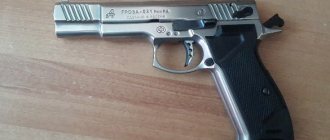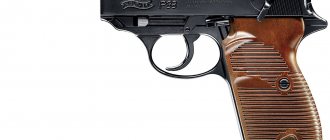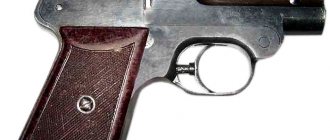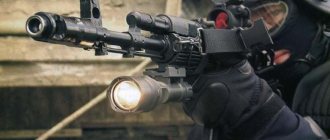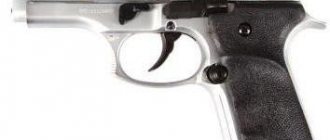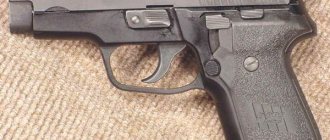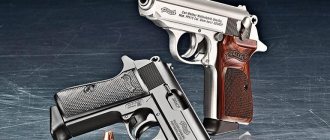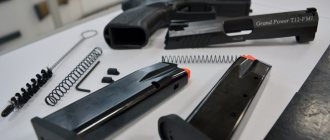Type of universal machine gun
| Type 80 general purpose machine gun | |
| Syrian soldier with Type 80. | |
| Type | Universal machine gun |
| Place of origin | China |
| Service history | |
| In service | 1983–present |
| Used | See Users |
| Wars | Lebanese Civil War Second Sudanese Civil War [1] War in Darfur Sri Lankan Civil War Ethnic violence in South Sudan Sudanese conflict Syrian Civil War Boko Haram insurgency |
| Production history | |
| Designer | Mikhail Kalashnikov [2] |
| Designed by | 1980 |
| Manufacturer |
|
| Produced | 1983–present [3] |
| Options | View options |
| Characteristics | |
| Weight | 12.6 kg (27.78 lb) |
| Length | 1192 mm (46.9 in) |
| Barrel length | 658 mm (25.9 in) |
| Cartridge | 7.62 × 54 mmR |
| Action | Gas, open shutter |
| Rate of fire | 700–800 rpm |
| starting speed | 840 m/s (2,776 ft/s) |
| Effective firing range | 1,640 yards (with scope adjustment 100-1,500 m) |
| Feeding system | Belts in boxes 100/200/250 round |
| Attractions | Open attractions. Optical/night vision installation possible. |
Type 80
(Chinese: 80式通用机枪) is a general purpose machine gun manufactured by Norinco in China, based on the Soviet PKM. The machine gun was certified for design modification in 1980 and entered service with the PLA in the mid-1980s, namely in 1983. [3] The Type 80 was intended as a successor to the independently developed Chinese Type 67, which had performed well in tests conducted at the Chengdu Military Region before it was dropped and, instead, decided to keep the Type 67 GPMG in use. [3]
Only a few Type 80s were used by the People's Liberation Army Marine Corps and airborne units, and a modified Type 80, called the Type 86, was then adopted by the PLA armored units. [4]
History[edit]
Development of the GPMG began when Chinese firearms engineers studied PKMs captured from Vietnamese troops during the Sino-Vietnamese War. [4]
Changfeng Machinery was subcontracted to build the CS/LM4 to be chambered in 7.62 NATO caliber. [5] The CS/LM4 was sold to countries that used Soviet/Eastern European/Chinese-made small arms but focused on using NATO ammunition. [5]
Design[edit]
The Type 80 fires 7.62×54mmR cartridges. It is a fully automatic, gas powered, air cooled, belt fed firearm. It can shoot both from a tripod and from a folding bipod on a gas pipe under the barrel. [6] Belts are used from 100-round boxes in light machine gun configurations and from 200- or 250-round boxes in tripod mountings. The machine gun uses an open iron sight, but can also be equipped with an optical or night vision sight. [6]
Chinese pistols (Part II)
(End. Beginning in the article “Chinese pistols (Part I)
)»)
PISTOL TYPE 80
Especially for the PLA special forces units in China in 1980, the modernized 7.62-mm Mauser M.712 automatic pistol under the designation “type 80” was adopted. It was designed to use the 7.62x25 type 51 pistol cartridge. It was assumed that the new model would become an analogue of the small-sized submachine gun needed by reconnaissance and sabotage units and subunits.
The automatics of the Type 80 pistol worked on the principle of using the recoil energy of the barrel during its short stroke. The barrel is rigidly connected to the frame, inside of which there is a rectangular bolt. The bolt was locked by a combat cylinder, swinging in a vertical plane and located under the bolt.
Shooting from an automatic pistol type 80
The trigger mechanism of the new Chinese pistol had a fire mode selector, designed in the early 1930s by German gunsmiths Josef Nickel and Karl Westinger and allowing for single and continuous fire with a rate of fire of 850 rounds/min. This, together with removable box magazines for 10 and 20 rounds, made it possible to use the weapon as a submachine gun for close combat. Despite the fact that the Type 80 pistol was designed for targeted shooting at a distance of up to 1000 m, it showed the best results when firing with a single fire when firing at a distance of up to 100 m. The external differences between the Type 80 pistol and its German predecessor were the characteristically tilted magazine forward ; improved pistol grip shape and slightly modified frame shape.
However, this sample also had many disadvantages. Thus, when firing in short bursts, the thin-walled barrel quickly heated up, which could lead to self-ignition of the next cartridge fed into the chamber from the magazine. After three bursts of 10 shots, the Type 80 pistol became so hot that the next shot could occur within 10 seconds even with the bolt not fully closed.
Total length (without stock) - 300 mm; barrel length 140 mm; weight without magazine 1.16 kg; initial bullet speed - 470 m/s.
PISTOL TYPE 84
The 7.65 mm Type 84 self-loading pistol was developed specifically by order of the Ministry of Public Security of the People's Republic of China to combat terrorists on board aircraft and other vehicles. For this pistol, a special version of the 7.65x17 type 64 cartridge was designed, equipped with a bullet with reduced penetration and stopping effect. It received the index type 84. The bullet of this pistol cartridge with a plastic core, when fired, did not penetrate the side of a civil aircraft from a distance of 2 meters. The effective firing range for people is approximately 15 meters. In addition, the Type 84 pistol could also use older 7.65 mm Type 64 pistol cartridges.
The Type 84 pistol, which had minimal weight and dimensions, was especially convenient for concealed carry. The automatic operation of this pistol, copying the design of the Belgian 6.35-mm Browning M 1906 pistol, used the recoil of a free bolt. The trigger mechanism is striker type, single action. The safety lever is mounted on the left side of the frame. Sights consist of a front sight and a permanent rear sight.
Total length - 121 mm; barrel length 56 mm; weight without cartridges - 0.38 kg; Magazine capacity - 6 rounds.
GUN TYPE QSZ 92
9 mm pistol type QSZ 92 (in export version) and 5.8 mm pistol type QSZ 92 (in version for the PLA) with pistol cartridges 9 mm DAP 92 and 5.8 mm DAP-5.8
At the end of the past century, China, following Belgium, rightfully considered the trendsetter in weapons fashion, has created a completely new model of personal weapons of the 21st century. Chinese military experts, as a result of many years of research, also came to the conclusion that it is necessary to more clearly outline the range of main combat missions performed in battle by an infantryman using small arms: individual and group defense; assault operations at short distances and defeat of manpower at long ranges. It was taken into account that almost all military personnel of the armed forces of potential adversaries taking part in combat operations in modern wars and low-intensity military conflicts can be equipped with personal protective equipment - body armor of five levels of protection, and these means will only be constantly improved in the future.
Therefore, Chinese experts decided to create a new “ammunition-weapon” complex, designed to use a special 5.8 mm pistol cartridge DAP 5.8, which replaced the outdated 7.62 mm pistol cartridge type 51. Fundamentally new 5.8x21 the low-impulse cartridge DAP 5.8 with a bottle sleeve and a pointed bullet (being much smaller than a machine gun, although outwardly reminiscent of a machine gun cartridge), was still pistol ammunition. However, its characteristics exceeded those of all currently available pistol cartridges. It had greater penetration and lethality, as well as a flatter flight trajectory than other types of pistol cartridges, including the main pistol cartridge, the 9-mm NATO (“Parabellum”).
The use of new, longer cartridges in this pistol resulted in the QSZ 92 having a longer pistol grip than other models, but it fit comfortably in the shooter's hand. The recoil impulse when firing from it was felt weaker than from a weapon designed for the 9-mm Parabellum cartridge, so the new Chinese pistol turned out to be easy to control. It has a frame made of impact-resistant polymer materials, which reduces the weight of the weapon to 0.76 kg. Moreover, a single module made of steel is inserted into the frame on top and combines both the guide grooves for the bolt and the body of the trigger mechanism. The inserts on the pistol grip are replaceable and allow you to adjust the size of the grip. There are also plastic inserts on the sides on the back of the bolt housing, making reloading easier.
5.8-mm pistol type QSZ 92 with a device for silent-flameless shooting and an optical sight
The automatic pistol QSZ 92 works on the principle of using recoil with a short barrel stroke. The bolt is locked by turning the barrel. The trigger mechanism is double action. The double-sided safety lever is mounted on the frame and additionally serves to safely release the hammer from cocking. The double-row magazine is designed for 20 5.8 mm DAP 5.8 pistol cartridges or 15 9 mm DAP 92 pistol cartridges (a Chinese copy of the 9x19 Parabellum cartridge). Under the barrel on the frame there are guide grooves for attaching a tactical combat flashlight or laser target designator. It can be equipped with a device for silent and flameless shooting. The export model of the QSZ 92 pistol, created for the 9-mm Parabellum cartridge, has an enlarged trigger guard of a complex shape that allows shooting with thick gloves, and a concave recess on its front part allows for the application of the index finger of the supporting hand. This pistol can be fired from both the right and left hands, as well as from both hands. The model of the 5.8 mm QSZ 92 pistol for the PLA has a rounded trigger guard, which characterizes the Chinese shooting technique from short-barreled weapons, which is different from the Western one.
Total length - 190 mm; barrel length 115 mm; weight without cartridges - 0.76 kg.
Along with its own developments, the Chinese state corporation NORINCO offers its foreign customers a large number of export models of foreign pistols manufactured in China.
PISTOL NORINCO M 1911A1
9-mm NORINCO NP 28 pistol
This pistol is an exact copy of the legendary American Colt M 1911A1 pistol, designed to use .45 ACP pistol cartridges.
The automatic operation of the NORINCO M 1911A1 pistol works on the principle of using recoil with a short barrel stroke. The design features of this pistol include the locking of the barrel bore by the engagement of the lugs on the breech of the barrel with the lugs made on the inner surface of the bolt housing. Their disengagement occurs during rollback due to the lowering of the barrel, which is hinged to the frame by one earring. The return spring is located under the barrel in the frame channel. The NORINCO M 1911A1 pistol has two safeties - a mechanical safety lever, located on the frame, and an automatic one, mounted on the rear wall of the pistol grip. The trigger mechanism has a disconnector that separates the trigger sear from the trigger rod. Single-row magazine with a capacity of 7 rounds. When the cartridges are used up, the magazine feeder raises the bolt stop and the bolt housing remains in the rear position. The bolt stop flag, safety lever and push-button magazine release are mounted on the left side of the frame, the cheeks of the handle are made of brown plastic. Total length - 218 mm; barrel length - 127 mm; weight - 1.13 kg.
.45 pistol NORINCO NP 30 and cartridges for it
The North China Industrial Corporation also produces several modifications of the Colt M 1911A1 pistol: - NORINCO M 1911 P10 pistol (export index "NP 30"), designed for use of .45 ACP cartridges and equipped with a double-sided safety catch, pistol grip cheeks with finger grooves made of black rubber and a magazine with a capacity of 10 rounds; — a sports version of the NORINCO M 1911P9 pistol (export index “NP 28”), designed to use 9x19 Parabellum pistol cartridges with a magazine capacity of 9 rounds; - another sports modification of this pistol, NORINCO M 1911P15 (export index “NP 29P15”) has a wider frame designed for a double-row magazine with a capacity of 15 rounds of 9x19 Parabellum cartridges;
Along with this, NORINCO offers Western European buyers another Chinese pistol, NORINCO M 1911A1C, whose design was also “borrowed” from American gunsmiths. It is based on the Colt Commander pistol and is a shortened and lightweight Colt M 1911A1, also designed to use .45 ACP pistol cartridges. Its characteristic distinctive features: the trigger spoke has a rounded shape, and three white insertion dots are mounted on the sighting device - the front sight and the fixed rear sight - for targeted shooting in conditions of poor visibility. The total length is 200 mm, barrel length is 109 mm, weight is 1.09 kg, magazine capacity is 7 rounds.
PISTOL NORINCO NP 18
At the end of the 1990s, Chinese gunsmiths exported their copies of the Belgian Browning HP pistol, including the NORINCO NP 18 pistol, the design of which largely replicates this model. It is also designed to use 9x19 Parabellum pistol cartridges, however, unlike the prototype, the new Chinese model received a double-action trigger mechanism, and the safety lever, which also serves as a safety release lever, was mounted on the left side of the bolt housing. Total length - 204 mm, barrel length - 118.5 mm, weight without cartridges - 1.0 kg, magazine capacity of 14 rounds.
PISTOL NORINCO NP 38
At the same time, the NORINCO corporation mastered the production of an analogue of the Browning HP Mk.III pistol, designated “NORINCO NP 38”. Although in this case there were some Chinese innovations - unlike the Belgian prototype, the NORINCO pistol used a double-action trigger mechanism. The design of the NP 38 trigger mechanism includes both a safety lever mounted on the left side of the frame and an automatic firing pin safety. This pistol is designed to use 9x19 Parabellum pistol cartridges. Total length - 200 mm, barrel length - 118.5 mm, weight - 0.9 kg, magazine capacity - 8 rounds.
PISTOL NORINCO PPN
9-mm NORINCO PPN pistol
The modern realities of the Chinese economy made it possible in the same years to master the production in China of an analogue of the Hungarian copy of one of the most famous German Walter PP pistols - the 9-mm FEG AR pistol. This slightly modified (compared to the original) weapon, intended specifically for export, received the “NORINCO PPN” index. The Chinese Walther PPN pistol, like its German and Hungarian ancestors, has a double-action trigger mechanism, and the frame is made like its Hungarian relative - from a lightweight alloy, while the bolt casing is made of steel. A safety lever is mounted on the left side of the frame, which also serves as a safety release lever. The PPN pistol is chambered for the 9 mm Browning Short cartridge. A permanent sighting device (front and rear sight) with three white dots facilitates shooting in low visibility conditions. Total length - 196 mm, barrel length - 100 mm, weight without cartridges - 600 g, magazine capacity - 8 rounds.
PISTOLS NORINCO NP 22 / NP 34
At the end of the 1990s, the Chinese released two more almost exact copies of German-Swiss pistols onto the world arms market: SIG-SAUER P 226 (index “NORINCO NP 22”) and P 228 (index “NORINCO NP 34”). This weapon was designed to use the 9x19 Parabellum pistol cartridge.
The automatic operation of the NORINCO NP 22 pistol worked on the principle of using recoil with a short barrel stroke. The barrel bore was locked by tilting the barrel. Double action trigger mechanism. The safety box is located on both sides of the pistol frame, which made it possible to use it for shooting with both left and right hands. When the safety is turned on, the trigger is automatically removed from the sear and placed on the safety cock, without blocking the bolt. Therefore, the parts of the trigger mechanism do not lock, which allows you to open fire immediately, by self-cocking. In addition, this model also featured an automatic firing pin safety and a safety release lever located on the left side of the frame. The pistol frame is made of lightweight alloy; the shutter casing is made of steel, and the cheeks of the handle are made of plastic. The sighting device is equipped with white dots - inserts. The perfected design of this pistol has become one of the best examples of modern short-barreled weapons with the NORINCO marking.
Total length - 196 mm, barrel length - 112 mm, weight without cartridges - 0.89 kg, magazine capacity - 15 rounds.
The second Chinese version of the German-Swiss pistol NORINCO NP 34 was an improved model created on the basis of the P 226 - the SIG-Sauer P 228, with reduced dimensions and a magazine capacity of 13 9x19 Parabellum pistol cartridges. Like the original, a safety release lever is mounted on the left side of the NP 34 frame. Its design differences: slightly different contours of the bolt casing and a new rounded trigger guard. To facilitate shooting in low visibility conditions, three luminous tritium dots were applied to the rear sight and front sight. The frame of the NP 34 pistol is made of lightweight alloy, and the bolt casing is made of steel. Total length - 108 mm, barrel length - 98 mm, weight - 0.74 kg.
PISTOL NORINCO NZ 75
9-mm pistol NORINCO NZ 75
The successful design of the famous Czech pistol CZ 75 attracted the close attention of Chinese gunsmiths. Since the CZ 75 promised to bring substantial dividends, the Chinese corporation NORINCO started copying this model. The automatic operation of the Chinese version of the CZ 75 - NZ 75 works on the principle of using recoil with a short barrel stroke with Browning-type locking, with a lowering of the barrel. An innovation in the NZ 75 pistol is that the slide slides along internal frame guides, giving it greater stability than along external guides (as happens in most other pistols). This design feature contributed to increased shooting accuracy and reliability of the moving parts of the automation. A double-action self-cocking trigger mechanism with an open hammer allows firing by self-cocking (with a trigger force of 5.5 kg) or with pre-cocking of the hammer (force 1.8-.9 kg). The flag-type fuse, unlike the Czech original, is mounted not on the frame, but on the bolt casing. The ergonomic shape of the pistol grip allows the weapon to fit deeply in the hand. The center of gravity of the pistol is shifted slightly forward, which reduces the tossing of the barrel when firing. In addition, the front part of the trigger guard has a reverse notch, which made it possible to use it for two-handed shooting. The sighting device is equipped with three white dot inserts. There is also a variant in which white vertical stripes are applied to the rear sight and front sight. The double-row magazine of increased capacity is designed for 15 9x19 Parabellum pistol cartridges. The NZ 75 can be equipped with handle cheeks made of black plastic or hard wood.
In addition to the NZ 75 series pistols, the Chinese have launched the production of its modernized version - the NORINCO NZ 85B pistol, which, in turn, is a copy of another Czech model - the CZ 85. The main differences between the NZ 85B and its predecessor are the safety flag and bolt on both sides of the frame delay, which made it more convenient to shoot from both the right and left hands. The trigger mechanism also underwent some changes - the firing pin received an automatic safety device. The pistol grip and trigger guard have been improved to make it easier to hold the pistol with both hands.
Total length - 208 mm, barrel length - 113.8 mm, weight - 1.0 kg.
Such a variety of Chinese pistols of various models allowed gunsmiths from the PRC to take into account the specific interests of certain states or population groups and confidently conquer their fairly large segment of the international arms market.
Sergey Monetchikov Photo from the author’s archive
Options [edit]
- Type 80
- a copy of the PKM GPMG chambered for 7.62 × 54 mmR. [5] - The Type 86
is a machine gun used only for tanks as a secondary weapon. [4] - The CF06
is an export version of the Type 80 chambered for 7.62 NATO. [7] [8] Research to create the CF06 began with evaluation between July and December 2006, with a prototype review in February 2007. [5] Production began from April to May 2007 before the CF06 was formalized in January 2008. [5] It features polymer furniture instead of the wood furniture used in the original Type 80. [9] Barrel life is 25,000 rounds, with 12,500 rounds for each of the two supplied barrels. [10] In 2008, it is also known as CS/LM4 GPMG (Chinese: CS/LM4型通用机枪). [4]
Foreign variants[edit]
- The BD-15
is a variant of the Type 80 manufactured by Bangladesh Ordnance Factories under license in 7.62 NATO caliber.
[11] [ unreliable source?
] - Mokhtar
is a variant of the Type 80 manufactured by the Military Industrial Corporation [12], caliber 7.62x54R. [13]
Modifications of the Toure 88 tank
- Type 80 - basic model, 1984, laser rangefinder located in the gun mantlet.
- Type 80-II - improved fire control system, experimental, 1985, laser rangefinder integrated into the gunner's sight.
- Type 88A (ZTZ88A) - 105 mm cannon with a barrel extended by 1 meter. The gun received the designation "83-1". A prototype has been manufactured.
- Toure 88B (ZTZ88B) - Toure 88 with an improved fire control system and an upgraded gun. In addition to the combined commander's sight and weapon stabilizer, the fire control system includes an integrated day/night gunner's sight with a stabilized field of view and a built-in laser rangefinder, an advanced digital ballistic computer with trunnion and gun axis tilt sensors, a wind sensor and a control panel. Apparently all Toure 88 tanks were brought to the “88B” level during scheduled repairs.
- Type 85 - a new tank built on the basis of the Type 88 with a welded turret and a 125 mm gun, 1989.
• Directory of armored vehicles • Tanks of the same period • Tanks of China •
Users[edit]
- Bangladesh: Made in Bangladesh variant of the BD-15, in service with the Bangladesh Army and the Presidential Guard Regiment. [14] [15]
- China: Currently in service with Chinese special forces in small numbers. [3] [6]
- Croatia: In service with Croatian police units during the War of Independence. [16]
- India: Captured from various rebels in the Kashmir Valley and used by Indian forces. [17]
- Malta: Armed Forces of Malta [18]
- Niger [19]
- South Sudan [1]
- South Sudan Democratic Movement: Mokhtar
[20] - South Sudan Defense Force: Type 80 [21]
- Sudan: Locally produced as Mokhtar
. [22] Also Chinese-made Type 80s. [21] - Sri Lanka: In service with the Sri Lanka Army. Around 200 Type 80 GPMGs have been supplied to Norinco as part of several defense agreements between China and Sri Lanka. [23]
Non-state actors[edit]
- Boko Haram [24]
- Islamic State [25]
- South Sudan Democratic Movement [26]
- South Sudan Liberation Movement [26]
- Nuer militias in South Sudan [26]
History[edit]
The basis for the development was the Kalashnikov machine gun (PKM). The model was approved and the machine gun entered service with the PLA in the 1980s in 1983. At first it was assumed that the Type 80 would replace the Type 67, previously developed in the PRC, which had proven itself well at the military district training ground in Chengdu. However, then development was curtailed, and only the Type 67 GPMG remained in service. Several Type 80 samples were tested in the Chinese Navy, then they were modernized, and the ground forces received a modification of the Type 86, which was put into service with the PLA.

